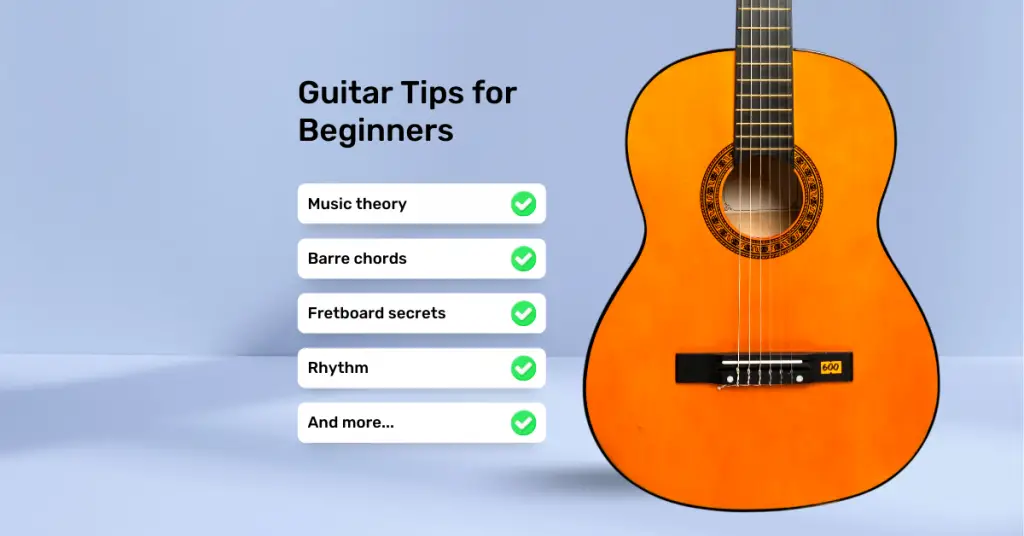Table of Contents
Tuning a guitar is the first thing you’ll do when you pick up a guitar.
With that being said, it’s vital that you understand how to tune a guitar.
Let’s dive in.
How to tune a guitar to standard tuning
Tuning a guitar to standard tuning doesn’t have to be complicated. Just tune each string, from the lowest pitch to the highest pitch, to E-A-D-G-B-E.
This is explained step-by-step below.
How to remember the string names and order
You can remember the guitar string names and order easily by memorizing simple phrases.
Some popular phrases/acronyms for memorizing the string names are:
- Every Artistic Dog Gets Bones Easily
- Eddie Ate Dynamite Good Bye Eddie
- Elephants Ate Donuts Gum Bad Elephants
Those are just 3 examples. There are dozens more floating around the web.
And remember, it’s important to note that these letters represent musical notes, and not just letters in the alphabet.
Tune a guitar, step-by-step
- Begin by selecting the appropriate tuning or pitch-producing device: an electronic tuner, piano/keyboard, or another guitar tuned to standard.
- Pluck the low E string of your untuned guitar and adjust the corresponding tuning head (machine head) accordingly.
- Repeat this process for strings A,D,G,B, and high E. Remember, you need each new open string to match with its respective note produced by your tuning device.
- Lastly, check all 6 strings again to make sure they’re in tune with one another. Once it’s done right your guitar will sound in tune as you strum an open chord.
How often you need to tune your guitar
As a general rule you need to tune your guitar at least once a day.
Tuning every day will help you better develop your pitch, plus it will help you get better at tuning.
On top of this, if you’re blasting out your neighbor’s ears you’ll at least be doing it in tune!
How to tune a guitar with a tuner
As a general rule the easiest way to tune a guitar is with an electronic tuner.
There are 3 common types of electronic tuners, which are outlined below.
Headstock Tuner
A headstock tuner is a tuner that clamps/clips onto your guitar’s headstock.
They’re extremely accurate, plus they’re most affordable and common type of tuner.
Smartphone Tuner
A smartphone tuner is a tuner built into an application.
Smartphone tuners are convenient, but less accurate than other electronic tuners.
Pedal Tuners
A pedal tuner is a guitar pedal with tuning capabilities. They are arguably the most accurate and efficient guitar tuner, but they are the most expensive types of tuners.
Best guitar tuners
Choosing the best guitar tuner is mostly preference, and most of them promoted in product articles are there because of brand partnerships/ affiliate relationships.
Even though online shopping is convenient, I suggest shopping at a local music/ guitar shop to find a tuner.
If you cannot resort to local guitar store, check out this article by Guitar World about the best guitar tuners. I believe the guitar community would agree that this is a great list of tuners overall.
How to tune a guitar without a tuner
Even though electronic tuners are the best way to tune a guitar, there are other ways to tune a guitar.
Tune a guitar using other instruments
You can tune a guitar using other instruments such as a piano.
The three biggest holdups with this method are:
- That instrument needs to be in-tune already
- You likely don’t have another instrument nearby all the time
- If you don’t know how to play the other instrument, you won’t know how to use it to tune a guitar
Overall, this is a fine method but is best executed when you have no other options.
Tune a guitar by ear, using its strings
Tuning a guitar by ear is an advanced guitar method, but it’s the easiest method if you’ve developed an ear for music.
In order to do this you’ll need a pitch for reference. This pitch is generally the Low E string.
Guitar Tuning Further Explained
What is the correct tuning for a guitar?
As a general rule the correct tuning for a guitar is E-A-D-G-B-E.
This tuning follow a series of fourth intervals, with the exception of a major third from the G string to the B string.
How do I keep my guitar in tune longer?
There are 4 common ways to keep your guitar in tune longer:
- Get a quality setup. This includes setting the intonation, properly adjusting the pickups, and checking the bridge height.
- Replace strings regularly. This will also help your guitar to sound better.
- Use digital tuners with enhanced accuracy.
- Lubricating and cleaning the machine heads, which is essential for any regular maintenance routine.
Conclusion: How to tune a guitar
In conclusion it’s vital that you tune your guitar every time you play!
Start by purchasing a clip-on electronic guitar tuner, and move onto tuning by ear from there.
Learn some alternate tunings, such as Drop D Tuning or E Flat Guitar Tuning, when you feel you’re ready.
The more you practice tuning, the easier and faster it will start to come to you!


